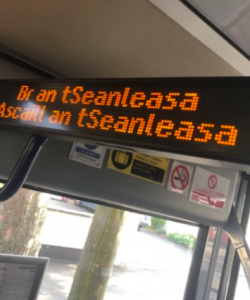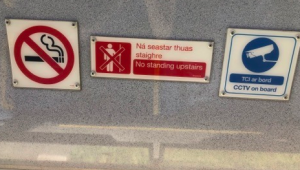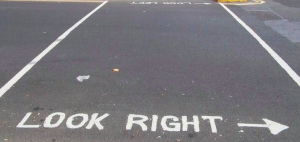Carson Fleming
Ling 343
Linguistic Landscape of Dublin Transportation
Dublin, Ireland is a small but growing city. In the recent years it has developed into a multicultural city. In the Dublin city center there is a wide range of different people and cultures. Although Dublin is growing into a more cultural and diverse city, it has also managed to preserve the Irish language and history. Throughout the country there are multiple traces of Irish history ranging from the transportation signs, to the Gaelic games, to the Irish languages being taught in schools. The majority of people in the city speak English, but Irish is still common in the older generations and in the country side. The linguistic landscape of Ireland shows a social and political preservation of Irish language and heritage, while also mixing in a modern multicultural landscape.
Using the bus transportation, I have noticed that every sign has English and Irish translations. The directions on where to go and the emergency exits on the bus also have both of the languages. The Irish translation is a reminder of the preservation of Irish culture and history. The signs support a multilingual community allowing a traditional older generation to have an Irish translation and a younger, multicultural generation to have an English translation.


I walk to work every day and throughout my commute I have noticed that on busy street crossings there is a sign on the ground that tells you which way to look. It either says look left or look right with arrows pointing in each direction. I found it interesting that there are directions specifically made to help Americans and other visitors who are not familiar with the flow of traffic. This example helps to show that Dublin is a multicultural city, making a reminder on the road to specifically help those who are not familiar with the traffic flow.

The linguistic landscape of Dublin shows a historical context of Irish history and a language that has been preserved throughout the years. The Irish translations throughout the city and on all forms of transportation and signs emphasizes the sociohistorical context of the language. As the article mentioned, the linguistic landscape is seen as a representation of space that are subjective representations rather than the physical environment (Leeman & Modan, 2009.) The linguistic landscape of Dublin addresses the complex social issues and past of Ireland in a subtle way.
After the famine of the nineteenth century in Ireland, the language was close to being extinct. A large portion of the population was wiped out, and the language was almost forgotten. However, an organization called The Society for the Preservation of the Irish Language, made an effort to preserve the language. The organization managed to push for the language to be learned in primary and secondary schools (Monaghan, 1899). Through Irish being taught in schools to translations throughout the city, it is obvious the state has made efforts to protect the language. Not only for those of different generations and background, but also for the history and preservation of the past of Ireland.
The linguistic landscape of Dublin shows a modern and growing multicultural city and a historical preservation of the past. Although Dublin is a fast growing city filled with multiple different cultures, there is still a past that has shaped Dublin into how it is today. By preserving the past language and acknowledging those who still use the language, there is a way for the present and past to connect.
References:
Monaghan, C. (1899). The Revival of the Gaelic Language. PMLA, 14, Xxxi-Xxxix. doi:10.2307/456448
Leeman, Jennifer, and Gabriella Modan. “Commodified language in Chinatown: A contextualized approach to linguistic landscape 1.” Journal of Sociolinguistics 13.3 (2009): 332-362.
Hi Carson,
Your insights into Dublin’s use of English to cater to tourists is very interesting. I wonder if the use of English is not only to help tourists but also the glorification/globalization of using English. Do you think that the Irish population looks up to Americans?
I think it is really interesting how you wrote about how the many different cultures present in Dublin cause them to put up signs to help people of other cultures understand the traffic flow. I thought it was also interesting how the use of the Irish language in Dublin and Ireland is mainly used for the preservation of their culture. Do you think that this is it’s main use, or that it is largely used as a vehicle for communication was well?
Hi Carson! I really enjoyed reading your well-structured essay. It is very interesting to observe how cultures make conscious efforts to hold on to traditions and history in an increasingly global society. I think the work of societies and organizations like the Society for the Preservation of the Irish Language are crucial in these processes. I hope you
Hi Carson! I really enjoyed reading your well-structured essay. It is very interesting to observe how cultures make conscious efforts to hold on to traditions and history in an increasingly global society. I think the work of societies and organizations like the Society for the Preservation of the Irish Language are crucial in these processes. I hope you’re enjoying Dublin, have a great summer!